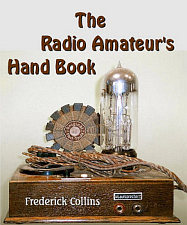
Radio Amateur's Hand Book

Description
Radio Amateur's Hand Book
A Complete, Authentic and Informative Work
on Wireless Telegraphy and Telephony
By
Frederick Collins
Inventor of the Wireless Telephone
For those boys that now wear men's clothing, a fond look back at our electronic hobbies: crystal radios, tube radios, radio transmitting, ham radio, etc.
**************
Excerpt:
The fact that the vacuum tube oscillator requires no adjustment of its elements, that its initial cost is much less than the oscillation arc, besides other considerations, is the reason that it popularized wireless telephony; and because continuous waves have many advantages over periodic oscillations is the reason the vacuum tube oscillator is replacing the spark coil as a wireless telegraph transmitter. Moreover, by using a number of large tubes in parallel, powerful oscillations can be set up and, hence, the waves sent out are radiated to enormous distances.
While oscillator tubes were being experimented with in the research laboratories of the General Electric, the Westinghouse, the Radio Corporation of America, and other big companies, all the youthful amateurs in the country had learned that by using a vacuum tube as a detector they could easily get messages 500 miles away. The use of these tubes as amplifiers also made it possible to employ a loud speaker, so that a room, a hall, or an out-of-door audience could hear clearly and distinctly everything that was being sent out.
The boy amateur had only to let father or mother listen-in, and they were duly impressed when he told them they were getting it from KDKA (the Pittsburgh station of the Westinghouse Co.), for was not Pittsburgh 500 miles away! And so they, too, became enthusiastic wireless amateurs. This new interest of the grown-ups was at once met not only by the manufacturers of apparatus with complete receiving and sending sets, but also by the big companies which began broadcasting regular programs consisting of music and talks on all sorts of interesting subjects.
This is the wireless, or radio, as the average amateur knows it today. But it is by no means the limit of its possibilities. On the contrary, we are just beginning to realize what it may mean to the human race. The Government is now utilizing it to send out weather, crop and market reports. Foreign trade conditions are being reported. The Naval Observatory at Arlington is wirelessing time signals.
Department stores are beginning to issue programs and advertise by radio! Cities are also taking up such programs, and they will doubtless be included soon among the regular privileges of the tax-payers. Politicians address their constituents. Preachers reach the stay-at-homes. Great singers thrill thousands instead of hundreds. Soon it will be possible to hear the finest musical programs, entertainers, and orators, without budging from one's easy chair.
In the World War wireless proved of inestimable value. Airplanes, instead of flying aimlessly, kept in constant touch with headquarters. Bodies of troops moved alertly and intelligently. Ships at sea talked freely, over hundreds of miles. Scouts reported. Everywhere its invisible aid was invoked.
In time of peace, however, it has proved and will prove the greatest servant of mankind. Wireless messages now go daily from continent to continent, and soon will go around the world with the same facility. Ships in distress at sea can summon aid. Vessels everywhere get the day's news, even to baseball scores. Daily new tasks are being assigned this tireless, wireless messenger.
Messages have been sent and received by moving trains, the Lackawanna and the Rock Island railroads being pioneers in this field. Messages have also been received by automobiles, and one inventor has successfully demonstrated a motor car controlled entirely by wireless. This method of communication is being employed more and more by newspapers. It is also of great service in reporting forest fires.
Colleges are beginning to take up the subject, some of the first being Tufts College, Hunter College, Princeton, Yale, Harvard, and Columbia, which have regularly organized departments for students in wireless.
Instead of the unwieldy and formidable looking apparatus of a short time ago, experimenters are now vying with each other in making small or novel equipment. Portable sets of all sorts are being fashioned, from one which will go into an ordinary suitcase, to one so small it will easily slip into a Brownie camera. One receiver depicted in a newspaper was one inch square! Another was a ring for the finger, with a setting one inch by five-eighths of an inch, and an umbrella as a "ground." Walking sets with receivers fastened to one's belt are also common. Daily new novelties and marvels are announced.
Meanwhile, the radio amateur to whom this book is addressed may have his share in the joys of wireless. To get all of these good things out of the ether one does not need a rod or a gun--only a copper wire made fast at either end and a receiving set of some kind. If you are a sheer beginner, then you must be very careful in buying your apparatus, for since the great wave of popularity has washed wireless into the hearts of the people, numerous companies have sprung up and some of these are selling the veriest kinds of junk.
288 pages - 7 x 8½ softcover - Print size, 12 point font
















